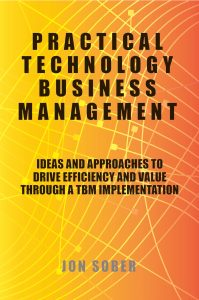
Ideas And Approaches To Drive Efficiency And Value Through A TBM Implementation
by Jon Sober
Overview
This book has been written to assist those people who are starting, and also those that are already involved, with the process of managing the cost of Information Technology, and looking for the appropriate way to manage that cost to deliver business value. A structured method to deliver this, Technology Business Management (TBM), will be introduced in terms of the ideas, approaches, challenges and responses that are involved.
The book is available on Amazon (UK, US, or your local store), or to order 5 or more copies at a reduced rate, please contact us.

Outline of the chapters
1. Introduction
The purpose of this book and its structure.
2. Technology and Business and Management
Background on Technology Business Management, including the Cost Model at its centre showing the value of technology expense, who TBM is useful for and how it fits into an organisation.
3. Where are you going?
Working out the potential and purpose of TBM, who the specific customers are and what they should gain from it, together with some ways to take action and show immediate value while preparing for the more complex tasks.
4. Where can you go?
Illustrating how some of the best practices available with a complete and mature TBM implementation can work, from the perspectives of the main groups involved; business, technology and finance.
5. Be realistic about getting there
Setting some expectations around the balance between complexity and achievement, this chapter looks at some approaches to implementing TBM, the organisational changes and impacts that may need to be planned, and the realistic effort and timelines for doing so.
6. Some decisions are hard to undo
Although there is a definition of the core TBM Taxonomy (see Appendix) and a structure associated with TBM, there are many routes to implementation. This degree of flexibility allows organisations to choose some options which may appear simple at the start, based on current knowledge or operations, but which need to be looked at more closely when they overlap into TBM. This chapter highlights several decisions which should be reviewed at an early stage of defining a TBM implementation strategy, and the implications.
7. Don’t do it
The flexibility and extensibility of TBM can also suggest that options for implementation may be realistic which are better avoided. Extending from the previous chapter, some specific approaches are reviewed here that are advised against, along with the reasons why.
8. Gathering information
The basis of creating a TBM Cost Model is the collection and integration of a range of information sources, where the value is then identified and managed by building relationships between those sources. The initial and subsequent processes for identifying, collecting and managing that data are reviewed.
9. Modelling vs Reality
The temptation in building any model is to aim for perfection in every detail, but neither perfect accuracy nor perfect understanding are required. This chapter looks at understanding the relevance of using standard approaches instead of customisation, plus setting expectations about the key limitations of modelling.
10. The mid-point(s)
Returning to the broader process of implementing TBM, this chapter focuses on the importance of Product and Service Catalogues and their governance within an organisation. This can be a critical factor in creating linkages between business processes and the underlying technology and costs.
11. Reaching the point of ‘But …’
Providing output from a TBM implementation usually introduces people to information in a form, or with a scope, that is different from what they are used to. One of the natural reactions to this is to challenge the information, so this chapter looks at some general objections that are heard and approaches to mitigating the information being rejected.
12. Who’s making decisions?
The value which TBM offers can be realised and recognised at both an individual level and at a business level. Understanding who is going to be able to gain in what way from TBM, and how a perceived negative impact in one area may be managed as part of a larger positive change, is reviewed.
13. Reporting
With a new range of information relationships available for review through TMB, this chapter provides an overview of how to understand and design reports that are relevant to the range of people who can benefit from TBM involvement.
14. Changing Behaviour
As all organisations change over time, the potential exists to use TBM to inform and drive change based on data rather than instinct. This section looks at a variety of changes and the impact they can have on behaviour through defining ownership, leaving gaps, and with both explicit and implicit goals.
15. Delivering capability and succeeding
It is possible to measure the maturity of TBM in multiple ways, so defining success can be incremental. This chapter looks at some of the measures used to identify progress on specific capabilities and how the level of maturity is not limited by reaching the point of implementation but continues into ongoing governance and continuous improvement.
16. The Bloopers reel
Despite everyone’s best efforts, it is still possible for things to go wrong. This final chapter anonymously documents some of the more unusual ways this has been seen.
